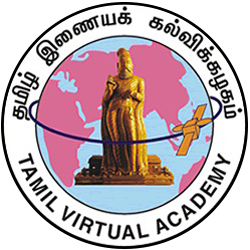Primary tabs
-
LESSON - 2
D02132 Vetchi Tinai
This lesson offers a brief definition of ‘tinai’
and ‘turai’. It then examines the various aspects of
‘ vetchi tinai’ and the 19 ‘turais’ that constitute it. The
term ‘ tinai’ may signify ‘kulam’ ie (class or
lineage), ‘ nilam’ ie (landscape) and‘ ozhukkam’
ie (behaviour). Broadly speaking, ‘tinai’ is used
to denote the conduct or behaviourie(ozhukkam)
pertaining to various aspects of public and domestic
life. Thus, ‘vetchi tinai’ speaks of ‘vetchi ozhukkam’
or the act of provoking a war by attacking and
stealing the cattle of the enemy. In those days cattle
symbolized the wealth of a kingdom and rival kings
often attacked and raided each other’s cattle to
establish their supremacy. The raided cattle were
then safeguarded by the victor. The various steps
in ‘Aaanirai Kavarthal’- or cattle raids and or ‘Aanirai
Kaathal’- protecting the stolen cattle constitute the
19 ‘ turais’ in ‘vetchi tinai’. The name ‘vetchi’ derives
from the custom of the ‘ maravar’ or (warriors)
wearing a vetchi flower when they set out on a
cattle raid. Vetchi Tinai is the parallel of ‘Kurunji
tinai’in‘Agam’.‘Vetchi Ozhukkam’ codifies the behaviour
pertaining to ‘Aaanirai Kavarthal’and ‘Aanirai Kaathal’
into 5 broad ‘nilaigal’ or progressive stages. These
are ‘ kavarthal’, ‘penal’, ‘ adaithal’, ‘pagutthal’ and
‘ vanangal.The 19 ‘turais’ or stepsin ‘vetchi ozhukkam’
fall under these 5 ‘ nilaigal’.‘Vetchi Ozhukkam’ is of
2 kinds - ‘mannuru thozhil’ and ‘thannuru thozhil’.The
‘ vetchi ozhukkam’ where in the soldiers seize the
cattle of an enemy as per the order of their king
who seeksto expand his kingdom is called ‘mannuru
thozhil’. In ‘thannuru thozhil’,the soldiers, aware of
their king’s aspirations, launch a cattle raid on their
own in order to please him.The 19 turais in vetchi tinai are: ‘vetchiaravam’,
‘ virichi’, ‘ selavu’, ‘vei’, ‘ puratirai’, ‘oorkolai’, ‘aakol’,
‘ pusal mattru’, ‘ surathuythal’, ‘thalaithottram’,
‘ thanthunirai’, ‘paatheedu’,‘undaattu’,‘ kodai’, ‘pulanari
sirappu’, ‘pillai vazhakku’, ‘ thudinilai’, ‘kottravai nilai’
and ‘veriyattu’. The lesson examines the names of
these turais and offers a brief definition of them.
‘ Vetchiaravam’ is a descriptionof the various noises
that arise when the soldiers set out on a cattle raid.
‘ Virichi’ is the act of divining the outcome of the
cattle raid by examining a chance phraseor word the
soldiers may happen to hear before they set out
on a cattle raid . ‘ Selavu’ denotes theprocession
of the soldiers towards the battle field. ‘Vei’
signifiesspying or the act of reconnaissance before
the actual raid. Stationing the troops outside the
heavily guarded cattle ranch of the enemy
is called ‘ puratirai’. Attacking and destroying the
tiny hamlets that house the cattle sheds is called
‘ oorkolai’. ‘Aakol’ is the act of seizing the
cattle after slaying the enemy soldiers. ‘ Pusal
Mattru’ refers to the attempts to bring the
conflict between the rival soldiers to a decisive end.
The triumphant soldiers carefully driving the cattle
captured, through the forests to their kingdom
is described in ‘ Surathuithal’. People await the
triumphant return of their soldiers at the city
gates. The soldiers’ arrival at the city gates is
narrated in ‘thalaithottram’. Soldiers formally
presenting the raided cattle to their king in front of
the people is depicted in ‘ thanthunirai’. ‘Paatheedu’
denotes the ritual of dividing the cattle among the
various warrior chieftains according to their ranks.
The soldiers are praised by their king and a feast
is held in their honour. The victory is celebrated by
drinking ‘ kal’ or toddy. ‘Undaattu’ speaks of
the hearts of the soldiers dancing with joy at
the honour bestowed on them. The custom of
showering giftson those who tookpart in the division
of the cattle is called ‘kodai’. The act of
honoring the spies for their service is called
‘ pulanari sirappu’. Similarly theperson who foretold
the outcome of the battle by interpreting the flight
of the‘ pillai’ bird is also venerated. This is called
‘ pillai vazhakku’. ‘Thudinilai’ signifies the custom
of honouring the man who plays the ‘thudi’ or
‘ udukkai’, a musical instrument. ‘ Kotravai nilai’ and
‘Veriyaattu’ symbolize the rituals of worship
carried out after successful cattle raids.




